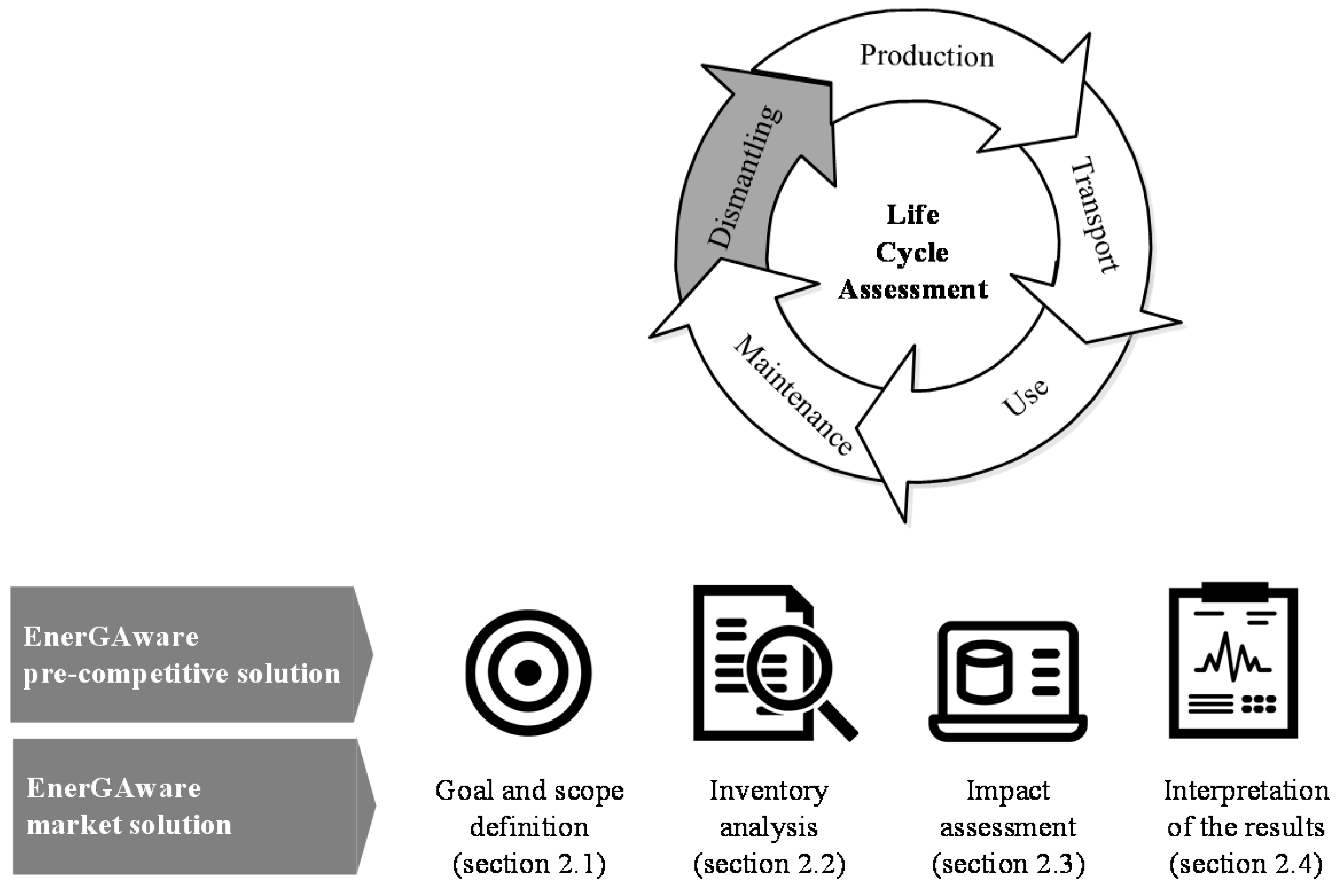Life Cycle Analysis of a Game-Based Solution for Domestic Energy Saving
Abstract
1. Introduction
2. Methodology
2.1. Goal and Scope Definition
2.2. Inventory Analysis
2.2.1. Production
2.2.2. Transport
2.2.3. Use
2.2.4. Maintenance
2.3. Impact Assessment
2.4. Interpretation of the Results
2.4.1. Environmental Impact of the EnerGAware Pre-Competitive Solution
2.4.2. Environmental Impact of the EnerGAware Market Solution
3. Discussion of the Results
4. Conclusions
Author Contributions
Funding
Conflicts of Interest
Nomenclature
| E | Ecosystems |
| FE | Freshwater eutrophication |
| FEC | Freshwater ecotoxicity |
| FR | Fossil resource scarcity |
| GWP | Global warming |
| H | Human health |
| HNCT | Human non-carcinogenic toxicity |
| IR | Ionizing radiation |
| LU | Land use |
| ME | Marine eutrophication |
| MEC | Marine ecotoxicity |
| MR | Mineral resource scarcity |
| OFH | Ozone formation, human health |
| OFT | Ozone formation, terrestrial ecosystems |
| PM | Fine particulate matter formation |
| R | Resources |
| SOD | Stratospheric ozone depletion |
| TA | Terrestrial acidification |
| TEC | Terrestrial ecotoxicity |
| WC | Water consumption |
References
- Europe. Directive (EU) 2018/844 of the European Parliament and of the Council of 30 May 2018 Amending Directive 2010/31/EU on the Energy Performance of Buildings and Directive 2012/27/EU on Energy Efficiency. 2018. Available online: https://eur-lex.europa.eu/legal-content/EN/TXT/PDF/?uri=CELEX:32018L0844&from=EN (accessed on 18 June 2020).
- Staddon, S.C.; Cycil, C.; Goulden, M.; Leygue, C.; Spence, A. Intervening to change behaviour and save energy in the workplace: A systematic review of available evidence. Energy Res. Soc. Sci. 2016, 17, 30–51. [Google Scholar] [CrossRef]
- Delzendeh, E.; Wu, S.; Lee, A.; Zhou, Y. The impact of occupants’ behaviours on building energy analysis: A research review. Renew. Sustain. Energy Rev. 2017, 80, 1061–1071. [Google Scholar] [CrossRef]
- Ornaghi, C.; Costanza, E.; Kittley-Davies, J.; Bourikas, L.; Aragon, V.; James, P.A. The effect of behavioural interventions on energy conservation in naturally ventilated offices. Energy Econ. 2018, 74, 582–591. [Google Scholar] [CrossRef]
- Rafsanjani, H.N.; Ahn, C.R.; Chen, J. Linking building energy consumption with occupants’ energy-consuming behaviors in commercial buildings: Non-intrusive occupant load monitoring (NIOLM). Energy Build. 2018, 172, 317–327. [Google Scholar] [CrossRef]
- Himeur, Y.; Alsalemi, A.; Al-Kababji, A.; Bensaali, F.; Amira, A. Data fusion strategies for energy efficiency in buildings: Overview, challenges and novel orientations. Inf. Fusion 2020, 64, 99–120. [Google Scholar] [CrossRef]
- Pasini, D.; Reda, F.; Häkkinen, T. User engaging practices for energy saving in buildings: Critical review and new enhanced procedure. Energy Build. 2017, 148, 74–88. [Google Scholar] [CrossRef]
- AlSkaif, T.; Lampropoulos, I.; van den Broek, M.; van Sark, W. Gamification-based framework for engagement of residential customers in energy applications. Energy Res. Soc. Sci. 2018, 44, 187–195. [Google Scholar] [CrossRef]
- Morganti, L.; Pallavicini, F.; Cadel, E.; Candelieri, A.; Archetti, F.; Mantovani, F. Gaming for earth: Serious games and gamification to engage consumers in pro-environmental behaviours for energy efficiency. Energy Res. Soc. Sci. 2017, 29, 95–102. [Google Scholar] [CrossRef]
- Johnson, D.; Horton, E.; Mulcahy, R.; Foth, M. Gamification and serious games within the domain of domestic energy consumption: A systematic review. Renew. Sustain. Energy Rev. 2017, 73, 249–264. [Google Scholar] [CrossRef]
- Boomsma, C.; Hafner, R.; Pahl, S.; Jones, R.; Fuertes, A. Should we play games where energy is concerned? Perceptions of serious gaming as a technology to motivate energy behaviour change among social housing tenants. Sustainability 2018, 10, 1729. [Google Scholar] [CrossRef]
- Ouariachi, T.; Elving, W.J.L.; Pierie, F. Playing for a Sustainable Future: The Case of We Energy Game as an Educational Practice. Sustainability 2018, 10, 3639. [Google Scholar] [CrossRef]
- Csoknyai, T.; Legardeur, J.; Akle, A.A.; Horváth, M. Analysis of energy consumption profiles in residential buildings and impact assessment of a serious game on occupants’ behavior. Energy Build. 2019, 196, 1–20. [Google Scholar] [CrossRef]
- Ponce, P.; Meier, A.; Méndez, J.I.; Peffer, T.; Molina, A.; Mata, O. Tailored gamification and serious game framework based on fuzzy logic for saving energy in connected thermostats. J. Clean. Prod. 2020, 262, 121167. [Google Scholar] [CrossRef]
- EnerGAware Project. Energy Game for Awareness of Energy Efficiency in Social Housing Communities. EU Funded Project, Contract Number: 649673. 2015. Available online: http://energaware.eu/ (accessed on 8 June 2020).
- Energy Cat. Energy Cat: The House of Tomorrow. 2017. Available online: http://www.energycatgame.com/ (accessed on 8 June 2020).
- Casals, M.; Gangolells, M.; Macarulla, M.; Fuertes, A.; Vimont, V.; Pinho, L.M. A Serious Game Enhancing Social Tenants’ Behavioral Change Towards Energy Efficiency. In Proceedings of the GIoTS 2017: Global Internet of Things Summit, Geneva, Switzerland, 6–9 June 2017; IEEE: Piscataway, NJ, USA, 2017; pp. 1–6. [Google Scholar]
- EnerGAware Project. Deliverable 5.4. Final Term Evaluation Report. 2018. Available online: http://energaware.eu/downloads/EnerGAware_D5.4_Final%20term%20evaluation%20report_r1.pdf/ (accessed on 11 June 2020).
- Casals, M.; Gangolells, M.; Macarulla, M.; Forcada, N.; Fuertes, A.; Hafner, R.; Jones, R. Assessing the effectiveness of gamification in reducing domestic energy consumption: Lessons learned from the EnerGAware project. Energy Build. 2020, 210, 109753. [Google Scholar] [CrossRef]
- Belkhir, L.; Elmeligi, A. Assessing ICT global emissions footprint: Trends to 2040 & recommendations. J. Clean. Prod. 2018, 177, 448–463. [Google Scholar]
- Van Dam, S.S.; Bakker, C.A.; Buiter, J.C. Do home energy management systems make sense? Assessing their overall lifecycle impact. Energy Policy 2013, 63, 398–407. [Google Scholar] [CrossRef]
- Gangolells, M.; Casals, M.; Forcada, N.; Macarulla, M.; Giretti, A. Environmental impacts related to the commissioning and usage phase of an intelligent energy management system. Appl. Energy 2015, 138, 216–223. [Google Scholar] [CrossRef]
- Louis, J.; Calo, A.; Leiviskä, K.; Pongrácz, E. Environmental impacts and benefits of smart home automation: Life cycle assessment of home energy management system. IFAC PapersOnLine 2015, 48, 880–885. [Google Scholar] [CrossRef]
- Beucker, S.; Bergesen, J.; Gibon, T. Building energy management systems. Global potentials and environmental implications of deployment. J. Ind. Ecol. 2016, 20, 223–233. [Google Scholar] [CrossRef]
- Gangolells, M.; Casals, M.; Forcada, N.; Macarulla, M.; Giretti, A. Energy performance assessment of an intelligent energy management system. Renew. Sust. Energy Rev. 2016, 55, 662–667. [Google Scholar] [CrossRef]
- Louis, J.; Pongrácz, E. Life cycle impact assessment of home energy management systems (HEMS) using dynamic emissions factors for electricity in Finland. Environ. Impact Assess. Rev. 2017, 67, 109–116. [Google Scholar] [CrossRef]
- Scheepens, A.; Vogtländer, J. Insulation or smart temperature control for domestic heating: A combined analysis of the costs, the eco-costs, the customer perceived value, and the rebound effect of energy saving. Sustainability 2018, 10, 3231. [Google Scholar] [CrossRef]
- International Standard Organization. ISO 14040. Environmental management—Life Cycle Assessment—Principles and Framework. Available online: https://www.iso.org/standard/37456.html (accessed on 18 August 2020).
- International Standard Organization. ISO 14044. Environmental Management—Life Cycle Assessment—Requirements and Guidelines. Available online: https://www.iso.org/standard/38498.html (accessed on 18 August 2020).
- Berg Insight. Smart Metering in Europe. Available online: https://www.marketresearch.com/Berg-Insight-v2702/Smart-Metering-Europe-13th-Edition-11295410/ (accessed on 18 August 2020).
- Swiss Centre for Life Cycle Inventories. Ecoinvent Database v3.4. Available online: http://www.ecoinvent.org/database/ (accessed on 8 October 2019).
- EnerGAware Project. Deliverable 4.2. Pilot Implementation Methodology. 2016. Available online: http://energaware.eu/downloads/EnerGAware_D4.2_Pilot%20implementation%20methodology_r1.pdf (accessed on 11 June 2020).
- EnerGAware Project. Deliverable 5.2. Baseline Monitoring and Evaluation Report. 2017. Available online: http://energaware.eu/downloads/EnerGAware_D5.2%20Baseline%20monitoring%20and%20evaluation%20report_r1.pdf (accessed on 23 October 2018).
- PRé. Simapro LCA Software 8.5.2.0. 2018. Available online: http://www.pre-sustainability.com/simapro (accessed on 29 November 2019).
- Huijbregts, M.A.J.; Steinmann, Z.J.N.; Elshout, P.M.F.; Stam, G.; Verones, F.; Vieira, M.; Zijp, M.; Hollander, A.; van Zelm, R. ReCiPe2016: A harmonised life cycle impact assessment method at midpoint and endpoint level. Int. J. Life Cycle Assess. 2017, 22, 138–147. [Google Scholar] [CrossRef]
- Nesticò, A.; Maselli, G. Declining discount rate estimate in the long-term economic evaluation of environmental projects. J. Environ. Account. Manag. 2020, 8, 93–110. [Google Scholar] [CrossRef]
- Dong, Y.; Miraglia, S.; Manzo, S.; Georgiadis, S.; Sørup, H.J.D.; Boriani, E.; Hald, T.; Thöns, S.; Hauschild, M.Z. Environmental sustainable decision making—The need and obstacles for integration of LCA into decision analysis. Environ. Sci. Policy 2018, 87, 33–44. [Google Scholar] [CrossRef]

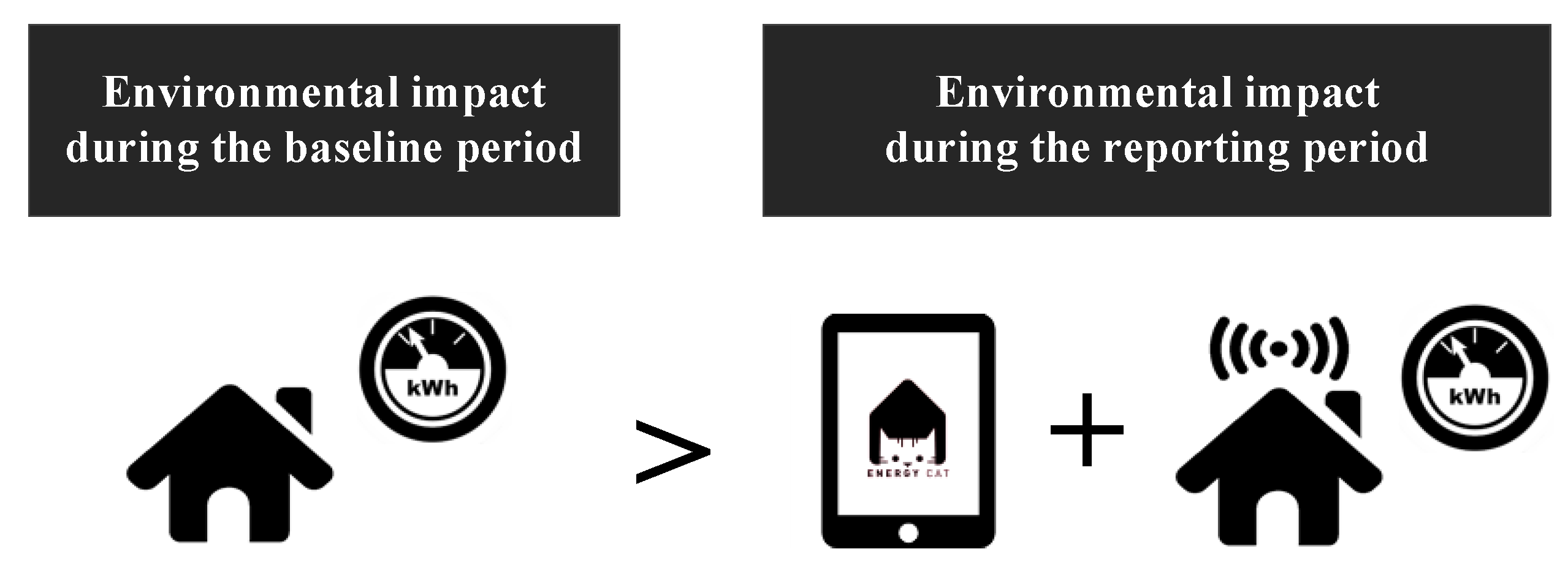
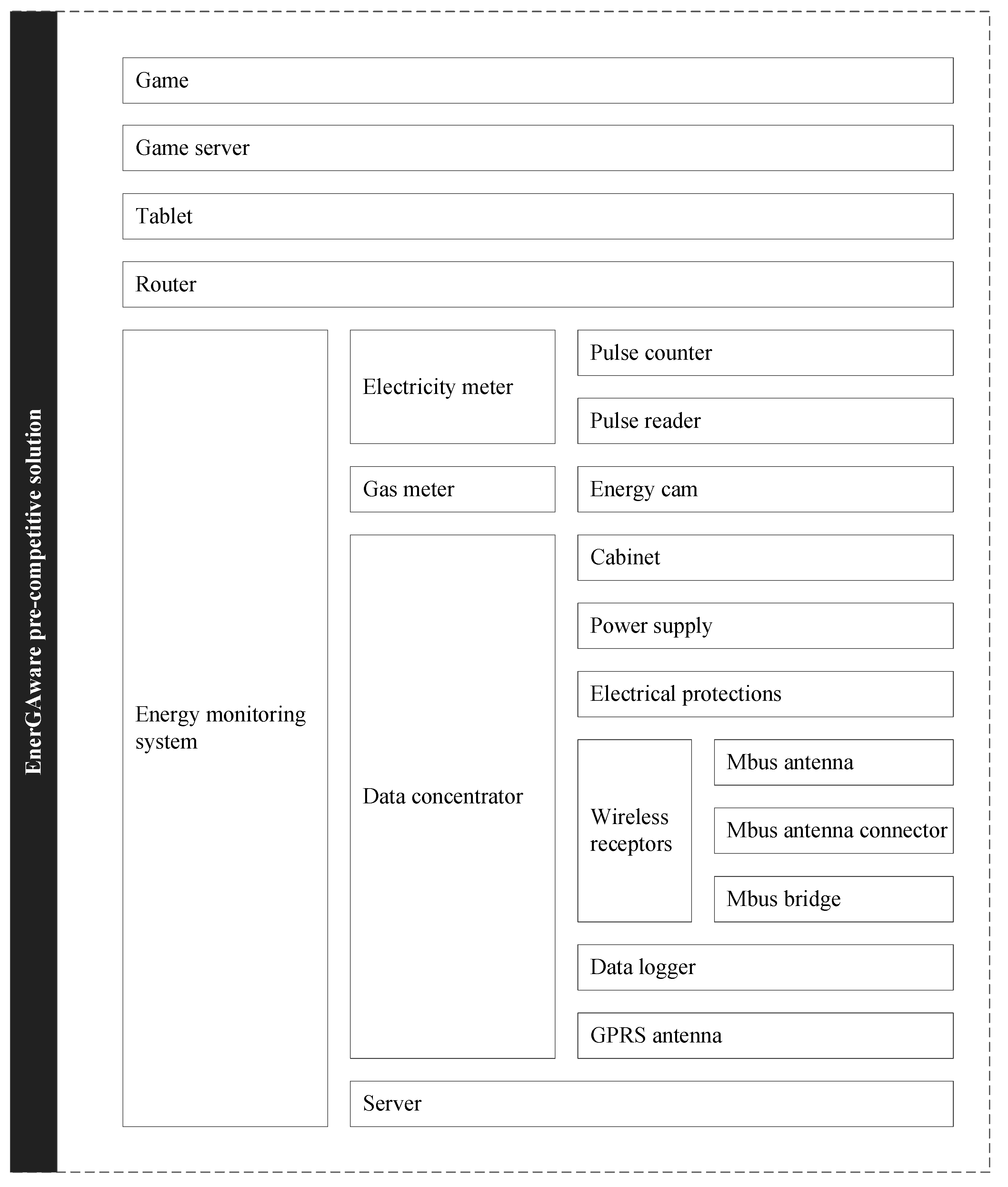
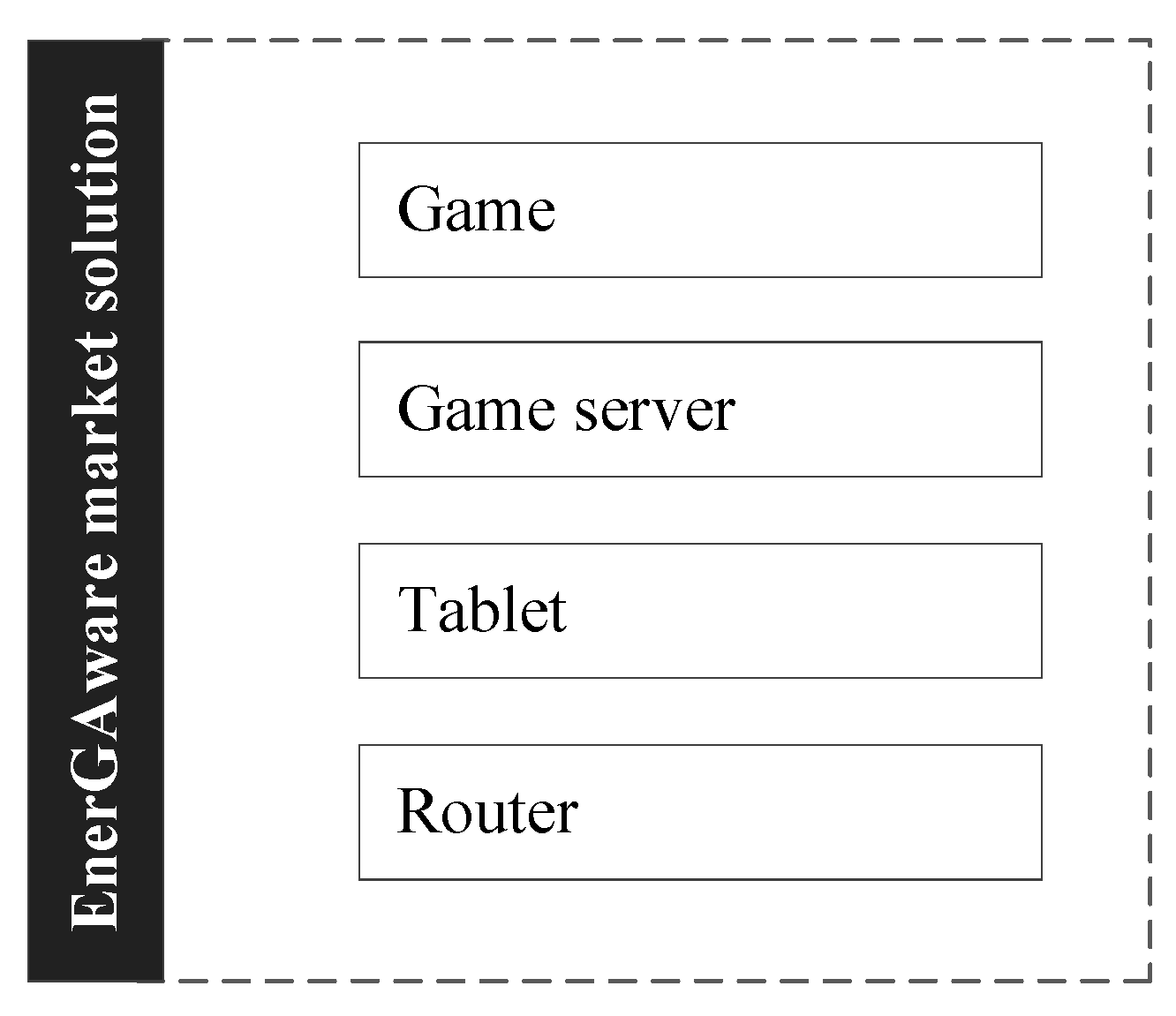

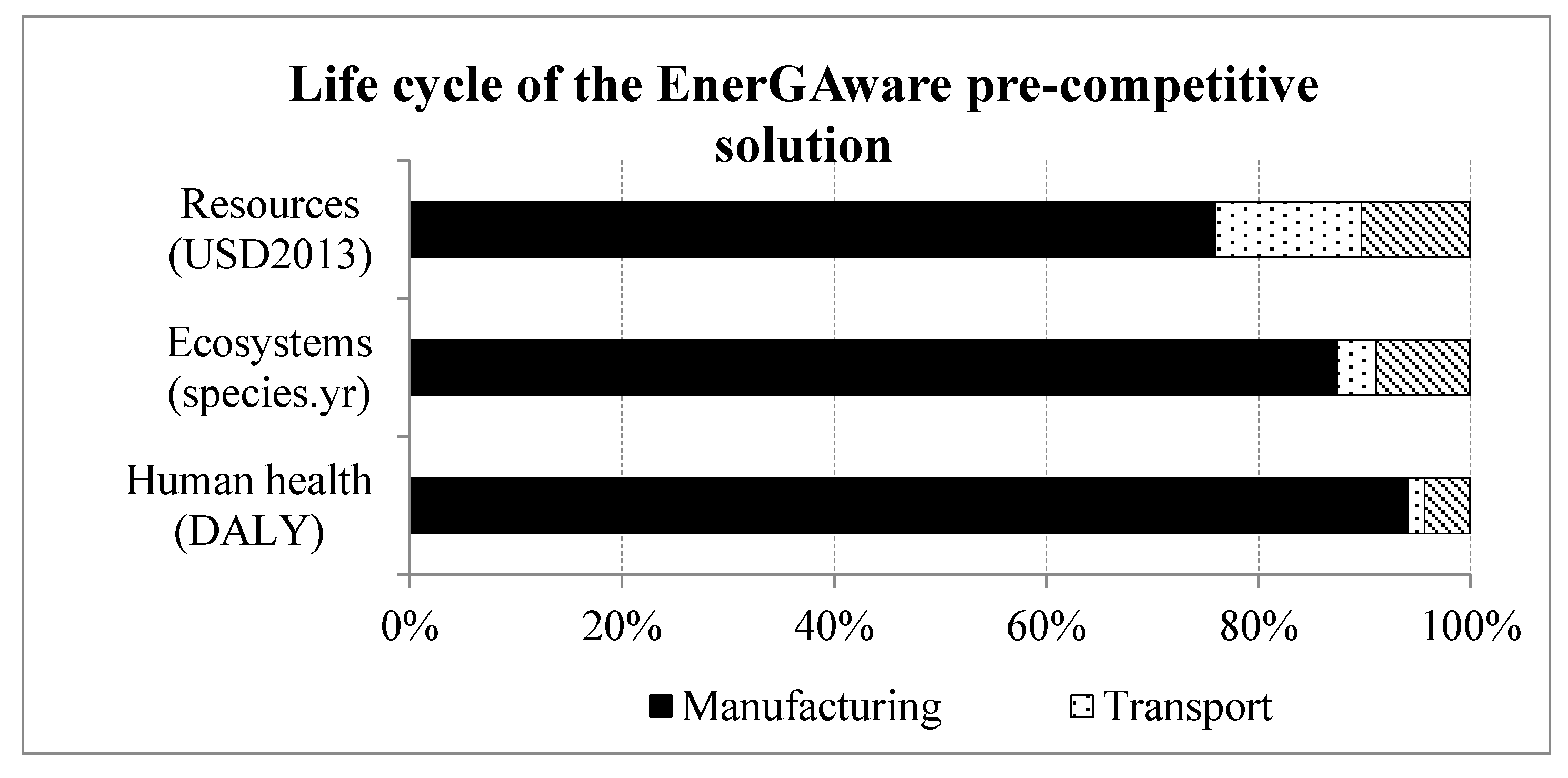
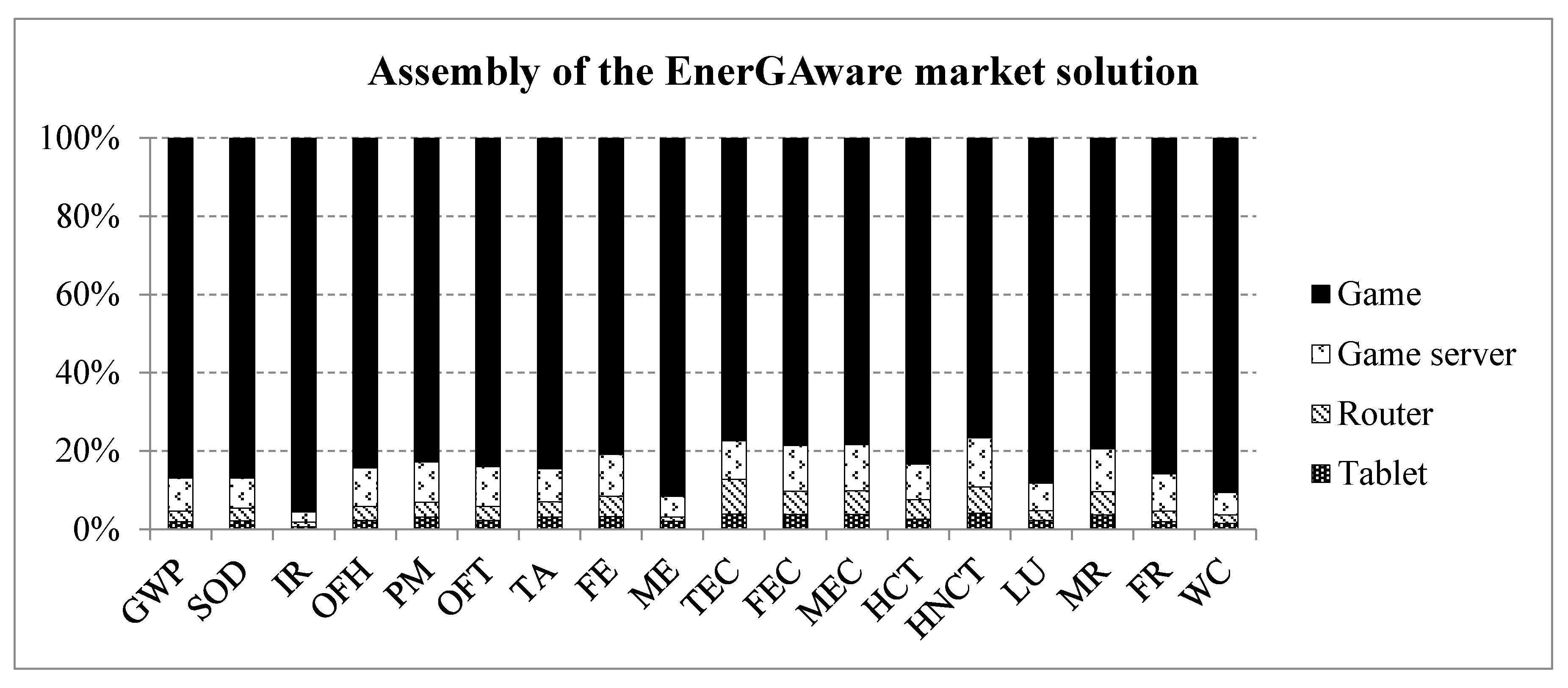
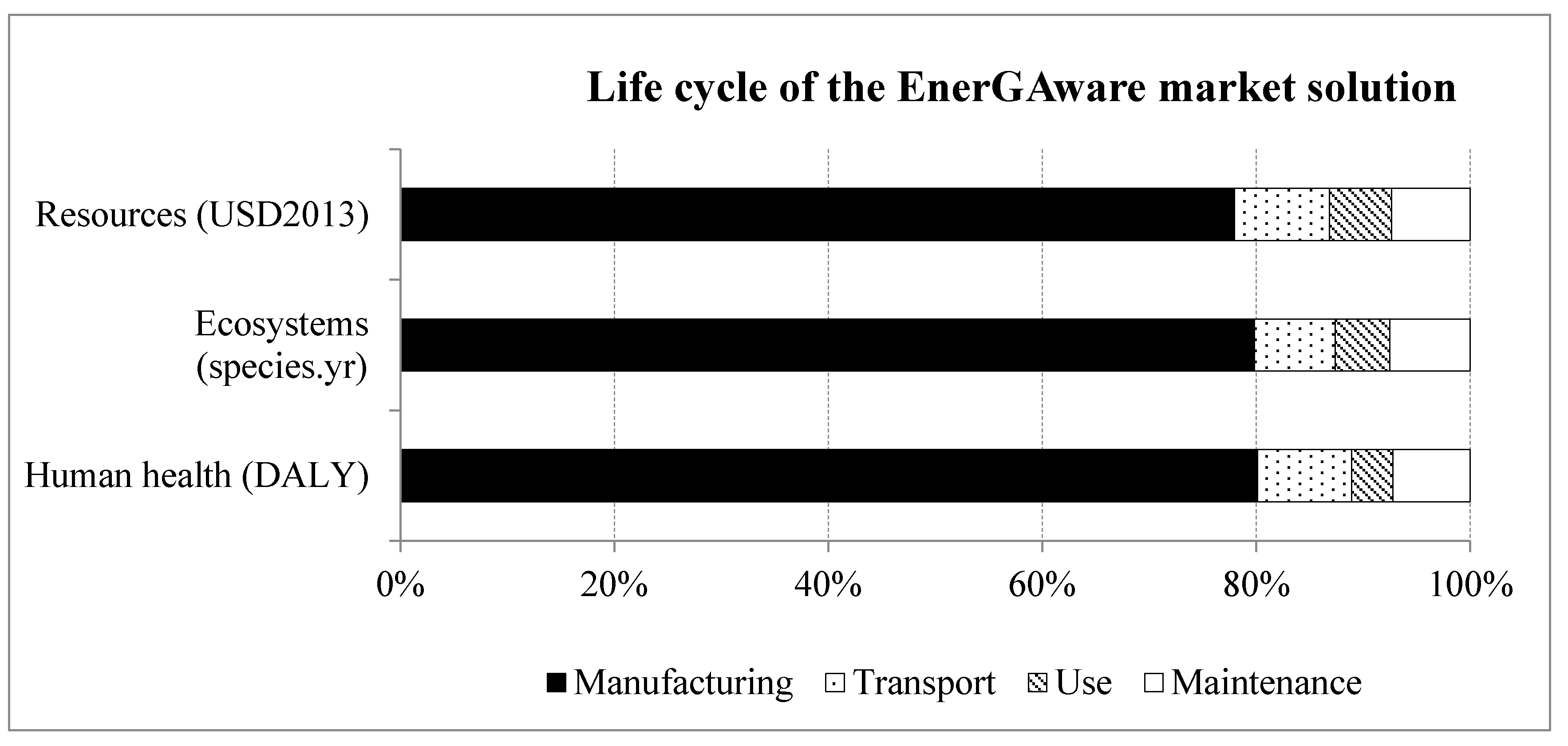
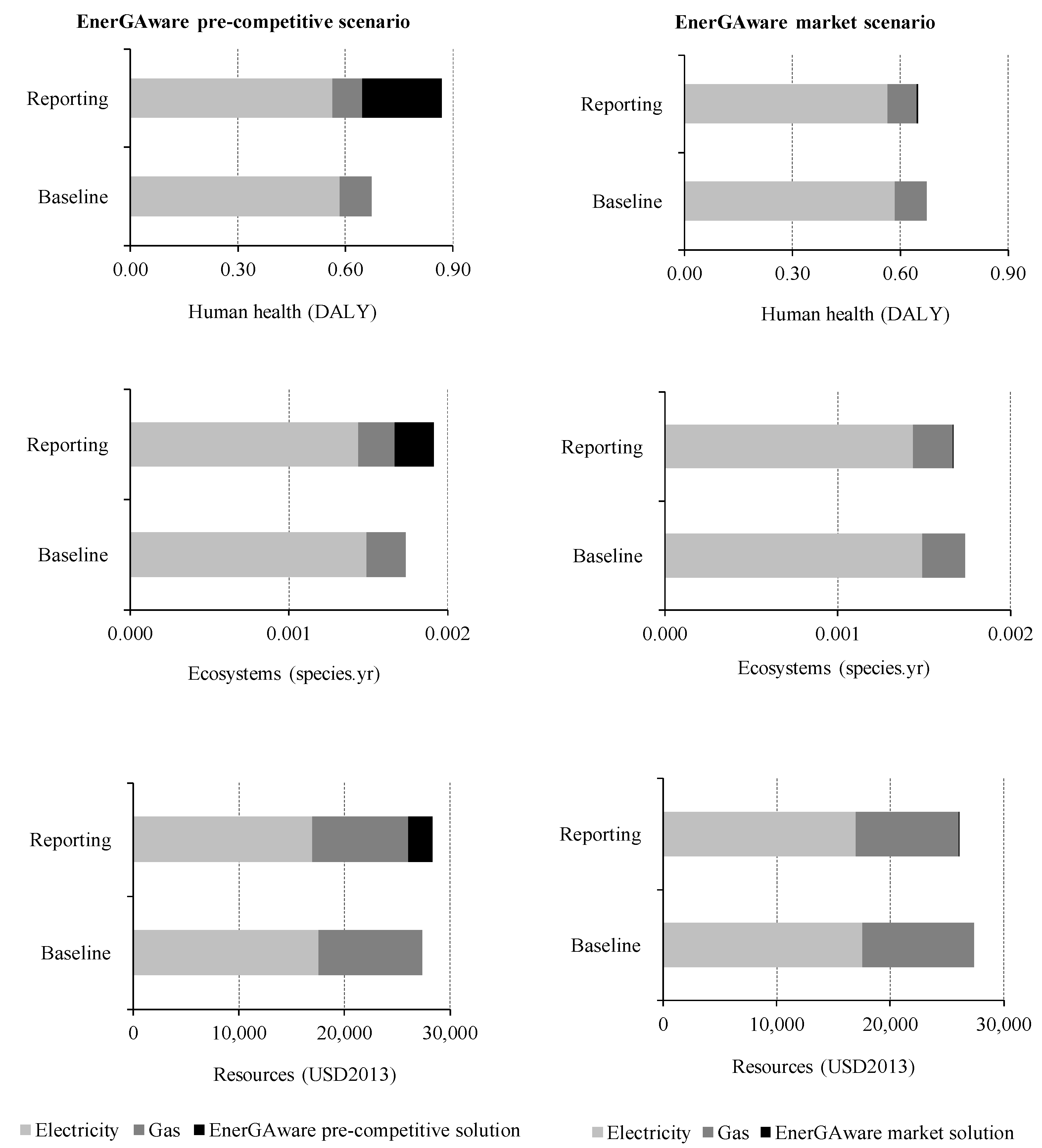
| EnerGAware Pre-Competitive Solution | EnerGAware Market Solution | |
| Game | 1 | 1 |
| Game server | 1 | 1 |
| Router | 50 | 50 |
| Tablet | 50 | 50 |
| Energy Monitoring System | ||
| Data concentrator | 50 | 0 |
| Electricity meter | 50 | 0 |
| Gas meter | 50 | 0 |
| Monitoring system server | 1 | 0 |
| Impact Category | Unit | Game System | Energy Monitoring System | Total | ||||||||
|---|---|---|---|---|---|---|---|---|---|---|---|---|
| Game | Game Server | Router | Tablet | Total | Data Concentrator | Electricity Meter | Gas Meter | Monitoring System Server | Total | |||
| GWP | kg CO2 eq 1 | 334.60 | 32.70 | 1857.33 | 1365.55 | 3590.17 | 8732.24 | 16,847.03 | 317.02 | 196.17 | 26,092.47 | 29,682.64 |
| SOD | kg CFC11 eq | 0.00 | 0.00 | 0.00 | 0.00 | 0.00 | 0.00 | 0.01 | 0.00 | 0.00 | 0.01 | 0.02 |
| IR | kBq Co-60 eq | 81.84 | 2.19 | 181.73 | 103.88 | 369.64 | 777.19 | 1585.00 | 29.46 | 13.13 | 2404.77 | 2774.41 |
| OFH | kg NOx eq | 0.74 | 0.09 | 5.62 | 3.72 | 10.16 | 23.27 | 48.42 | 0.93 | 0.52 | 73.14 | 83.30 |
| PM | kg PM2.5 eq | 0.66 | 0.08 | 5.58 | 4.42 | 10.74 | 20.35 | 37.09 | 0.88 | 0.49 | 58.80 | 69.54 |
| OFT | kg NOx eq | 0.76 | 0.09 | 5.73 | 3.81 | 10.38 | 23.67 | 49.15 | 0.95 | 0.55 | 74.32 | 84.70 |
| TA | kg SO2 eq | 1.50 | 0.15 | 12.63 | 10.13 | 24.41 | 41.20 | 69.47 | 1.95 | 0.89 | 113.51 | 137.92 |
| FE | kg P eq | 0.52 | 0.07 | 6.14 | 3.77 | 10.50 | 24.04 | 59.91 | 1.05 | 0.42 | 85.41 | 95.91 |
| ME | kg N eq | 0.10 | 0.01 | 0.21 | 0.39 | 0.69 | 0.69 | 1.43 | 0.03 | 0.03 | 2.19 | 2.88 |
| TEC | kg 1,4-DCB | 2152.72 | 274.29 | 45,040.79 | 19,371.85 | 66,839.65 | 93,631.07 | 49201.68 | 5676.10 | 1645.75 | 150,154.60 | 216,994.24 |
| FEC | kg 1,4-DCB | 75.11 | 11.22 | 1033.01 | 647.20 | 1766.54 | 3927.26 | 9932.38 | 175.37 | 67.30 | 14,102.32 | 15,868.86 |
| MEC | kg 1,4-DCB | 104.25 | 15.73 | 1464.62 | 908.04 | 2492.64 | 5541.22 | 13,964.09 | 248.12 | 94.40 | 19,847.83 | 22,340.47 |
| HCT | kg 1,4-DCB | 33.73 | 3.68 | 363.39 | 188.24 | 589.04 | 1052.13 | 2419.23 | 45.86 | 22.07 | 3539.29 | 4128.33 |
| HNCT | kg 1,4-DCB | 2219.96 | 365.13 | 35,645.11 | 21,228.69 | 59,458.88 | 134,335.38 | 340,467.35 | 6080.48 | 2190.76 | 483,073.97 | 542,532.85 |
| LU | m2a crop eq | 11.72 | 0.93 | 59.15 | 54.97 | 126.77 | 238.46 | 472.76 | 11.47 | 5.59 | 728.28 | 855.05 |
| MR | kg Cu eq | 4.67 | 0.64 | 64.32 | 38.48 | 108.12 | 201.07 | 467.89 | 9.61 | 3.86 | 682.43 | 790.55 |
| FR | kg oil eq | 80.64 | 8.97 | 448.47 | 336.32 | 874.40 | 2101.66 | 4047.30 | 80.16 | 53.81 | 6282.93 | 7157.33 |
| WC | m3 2 | 3.82 | 0.24 | 16.35 | 11.68 | 32.10 | 72.38 | 123.30 | 3.05 | 1.43 | 200.16 | 232.25 |
| Impact Category | Unit | Manufacturing | Transport | Use | Maintenance | Total | ||||||||
|---|---|---|---|---|---|---|---|---|---|---|---|---|---|---|
| Game System | Energy Monitoring System | Total | Game System | Energy Monitoring System | Total | Game System | Energy Monitoring System | Total | Game System | Energy Monitoring System | Total | |||
| GWP | kg CO2 eq 1 | 3590.17 | 26,092.47 | 29,682.64 | 567.95 | 1622.08 | 2190.03 | 24.27 | 4481.16 | 4505.42 | 37.17 | 0.73 | 37.90 | 36,415.99 |
| SOD | kg CFC11 eq | 0.00 | 0.01 | 0.02 | 0.00 | 0.00 | 0.00 | 0.00 | 0.00 | 0.00 | 0.00 | 0.00 | 0.00 | 0.02 |
| IR | kBq Co-60 eq | 369.64 | 2404.77 | 2774.41 | 8.60 | 19.48 | 28.08 | 245.60 | 693.75 | 939.34 | 9.09 | 0.07 | 9.16 | 3750.99 |
| OFH | kg NOx eq | 10.16 | 73.14 | 83.30 | 2.37 | 6.94 | 9.31 | 0.05 | 8.36 | 8.41 | 0.08 | 0.00 | 0.08 | 101.10 |
| PM | kg PM2.5 eq | 10.74 | 58.80 | 69.54 | 0.59 | 1.53 | 2.12 | 0.05 | 6.71 | 6.76 | 0.07 | 0.00 | 0.08 | 78.49 |
| OFT | kg NOx eq | 10.38 | 74.32 | 84.70 | 2.41 | 7.04 | 9.44 | 0.05 | 8.40 | 8.46 | 0.08 | 0.00 | 0.09 | 102.69 |
| TA | kg SO2 eq | 24.41 | 113.51 | 137.92 | 1.68 | 4.65 | 6.34 | 0.11 | 19.16 | 19.27 | 0.17 | 0.01 | 0.17 | 163.70 |
| FE | kg P eq | 10.50 | 85.41 | 95.91 | 0.08 | 0.04 | 0.12 | 0.01 | 1.39 | 1.40 | 0.06 | 0.00 | 0.06 | 97.50 |
| ME | kg N eq | 0.69 | 2.19 | 2.88 | 0.01 | 0.00 | 0.01 | 0.01 | 0.10 | 0.11 | 0.01 | 0.00 | 0.01 | 3.01 |
| TEC | kg 1,4-DCB | 66,839.65 | 150,154.60 | 216,994.24 | 788.55 | 1514.21 | 2302.76 | 271.91 | 5491.73 | 5763.64 | 239.15 | 31.62 | 270.77 | 225,331.41 |
| FEC | kg 1,4-DCB | 1766.54 | 14,102.32 | 15,868.86 | 12.34 | 3.16 | 15.50 | 10.40 | 219.93 | 230.33 | 8.34 | 0.30 | 8.64 | 16,123.34 |
| MEC | kg 1,4-DCB | 2492.64 | 19,847.83 | 22,340.47 | 17.73 | 5.69 | 23.42 | 12.86 | 281.15 | 294.01 | 11.58 | 0.42 | 12.00 | 22,669.90 |
| HCT | kg 1,4-DCB | 589.04 | 3539.29 | 4128.33 | 7.19 | 10.15 | 17.34 | 2.68 | 148.37 | 151.05 | 3.75 | 0.12 | 3.86 | 4300.58 |
| HNCT | kg 1,4-DCB | 59,458.88 | 483,073.97 | 542,532.85 | 401.50 | 101.96 | 503.46 | 61.74 | 2200.20 | 2261.94 | 246.62 | 10.15 | 256.77 | 545,555.02 |
| LU | m2a crop eq | 126.77 | 728.28 | 855.05 | 2.43 | 4.18 | 6.61 | 1.01 | 267.48 | 268.48 | 1.30 | 0.03 | 1.33 | 1131.46 |
| MR | kg Cu eq | 108.12 | 682.43 | 790.55 | 0.81 | 0.48 | 1.29 | 0.39 | 4.01 | 4.39 | 0.52 | 0.03 | 0.55 | 796.78 |
| FR | kg oil eq | 874.40 | 6282.93 | 7157.33 | 186.30 | 537.68 | 723.99 | 6.17 | 1134.12 | 1140.29 | 8.96 | 0.19 | 9.14 | 9030.75 |
| WC | m3 2 | 32.10 | 200.16 | 232.25 | 1.16 | 2.77 | 3.93 | 1.37 | 15.60 | 16.97 | 0.42 | 0.01 | 0.43 | 253.58 |
| Impact Category | Unit | Game | Game Server | Router | Tablet | Total |
|---|---|---|---|---|---|---|
| GWP | kg CO2 eq 1 | 334.60 | 32.70 | 10.18 | 7.48 | 384.96 |
| SOD | kg CFC11 eq | 0.00 | 0.00 | 0.00 | 0.00 | 0.00 |
| IR | kBq Co-60 eq | 81.84 | 2.19 | 1.00 | 0.57 | 85.60 |
| OFH | kg NOx eq | 0.74 | 0.09 | 0.03 | 0.02 | 0.88 |
| PM | kg PM2.5 eq | 0.66 | 0.08 | 0.03 | 0.02 | 0.79 |
| OFT | kg NOx eq | 0.76 | 0.09 | 0.03 | 0.02 | 0.90 |
| TA | kg SO2 eq | 1.50 | 0.15 | 0.07 | 0.06 | 1.78 |
| FE | kg P eq | 0.52 | 0.07 | 0.03 | 0.02 | 0.65 |
| ME | kg N eq | 0.10 | 0.01 | 0.00 | 0.00 | 0.10 |
| TEC | kg 1,4-DCB | 2152.72 | 274.29 | 246.80 | 106.15 | 2779.96 |
| FEC | kg 1,4-DCB | 75.11 | 11.22 | 5.66 | 3.55 | 95.53 |
| MEC | kg 1,4-DCB | 104.25 | 15.73 | 8.03 | 4.98 | 132.98 |
| HCT | kg 1,4-DCB | 33.73 | 3.68 | 1.99 | 1.03 | 40.43 |
| HNCT | kg 1,4-DCB | 2219.96 | 365.13 | 195.32 | 116.32 | 2896.72 |
| LU | m2a crop eq | 11.72 | 0.93 | 0.32 | 0.30 | 13.28 |
| MR | kg Cu eq | 4.67 | 0.64 | 0.35 | 0.21 | 5.88 |
| FR | kg oil eq | 80.64 | 8.97 | 2.46 | 1.84 | 93.90 |
| WC | m3 2 | 3.82 | 0.24 | 0.09 | 0.06 | 4.21 |
| Impact Category | Unit | Manufacturing | Transport | Use | Maintenance | Total |
|---|---|---|---|---|---|---|
| GWP | kg CO2 eq 1 | 384.96 | 35.63 | 24.27 | 37.17 | 482.02 |
| SOD | kg CFC11 eq | 0.00 | 0.00 | 0.00 | 0.00 | 0.00 |
| IR | kBq Co-60 eq | 85.60 | 2.22 | 245.60 | 9.09 | 342.51 |
| OFH | kg NOx eq | 0.88 | 0.10 | 0.05 | 0.08 | 1.11 |
| PM | kg PM2.5 eq | 0.79 | 0.08 | 0.05 | 0.07 | 1.00 |
| OFT | kg NOx eq | 0.90 | 0.10 | 0.05 | 0.08 | 1.14 |
| TA | kg SO2 eq | 1.78 | 0.16 | 0.11 | 0.17 | 2.21 |
| FE | kg P eq | 0.65 | 0.07 | 0.01 | 0.06 | 0.79 |
| ME | kg N eq | 0.10 | 0.01 | 0.01 | 0.01 | 0.13 |
| TEC | kg 1,4-DCB | 2779.96 | 277.11 | 271.91 | 239.15 | 3568.13 |
| FEC | kg 1,4-DCB | 95.53 | 11.22 | 10.40 | 8.34 | 125.50 |
| MEC | kg 1,4-DCB | 132.98 | 15.74 | 12.86 | 11.58 | 173.17 |
| HCT | kg 1,4-DCB | 40.43 | 3.70 | 2.68 | 3.75 | 50.56 |
| HNCT | kg 1,4-DCB | 2896.72 | 365.33 | 61.74 | 246.62 | 3570.41 |
| LU | m2a crop eq | 13.28 | 0.94 | 1.01 | 1.30 | 16.53 |
| MR | kg Cu eq | 5.88 | 0.64 | 0.39 | 0.52 | 7.43 |
| FR | kg oil eq | 93.90 | 9.94 | 6.17 | 8.96 | 118.98 |
| WC | m3 2 | 4.21 | 0.24 | 1.37 | 0.42 | 6.25 |
© 2020 by the authors. Licensee MDPI, Basel, Switzerland. This article is an open access article distributed under the terms and conditions of the Creative Commons Attribution (CC BY) license (http://creativecommons.org/licenses/by/4.0/).
Share and Cite
Gangolells, M.; Casals, M.; Forcada, N.; Macarulla, M. Life Cycle Analysis of a Game-Based Solution for Domestic Energy Saving. Sustainability 2020, 12, 6699. https://doi.org/10.3390/su12176699
Gangolells M, Casals M, Forcada N, Macarulla M. Life Cycle Analysis of a Game-Based Solution for Domestic Energy Saving. Sustainability. 2020; 12(17):6699. https://doi.org/10.3390/su12176699
Chicago/Turabian StyleGangolells, Marta, Miquel Casals, Núria Forcada, and Marcel Macarulla. 2020. "Life Cycle Analysis of a Game-Based Solution for Domestic Energy Saving" Sustainability 12, no. 17: 6699. https://doi.org/10.3390/su12176699
APA StyleGangolells, M., Casals, M., Forcada, N., & Macarulla, M. (2020). Life Cycle Analysis of a Game-Based Solution for Domestic Energy Saving. Sustainability, 12(17), 6699. https://doi.org/10.3390/su12176699






